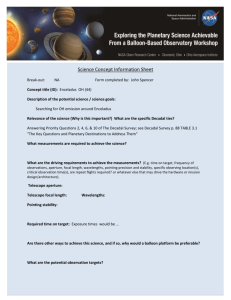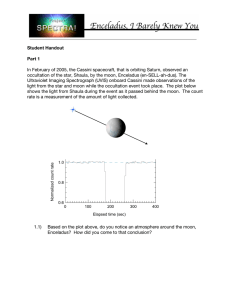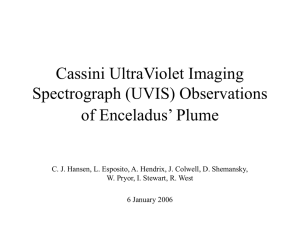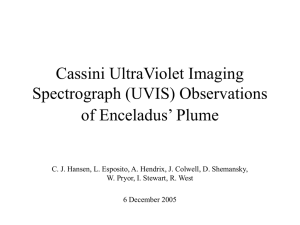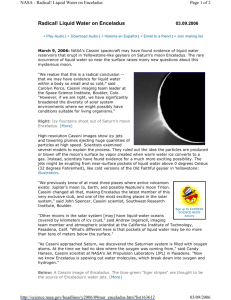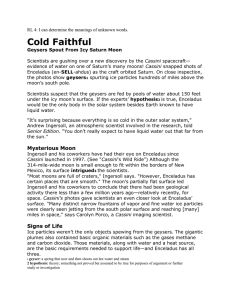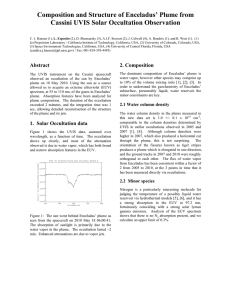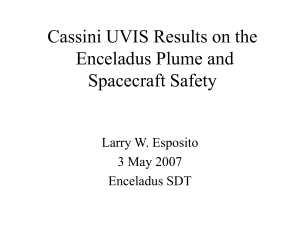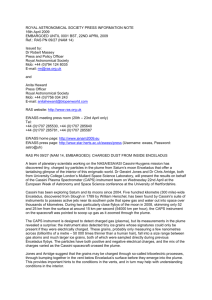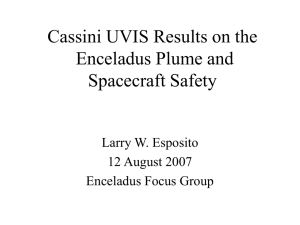Enceladus’ Water Vapour Plumes
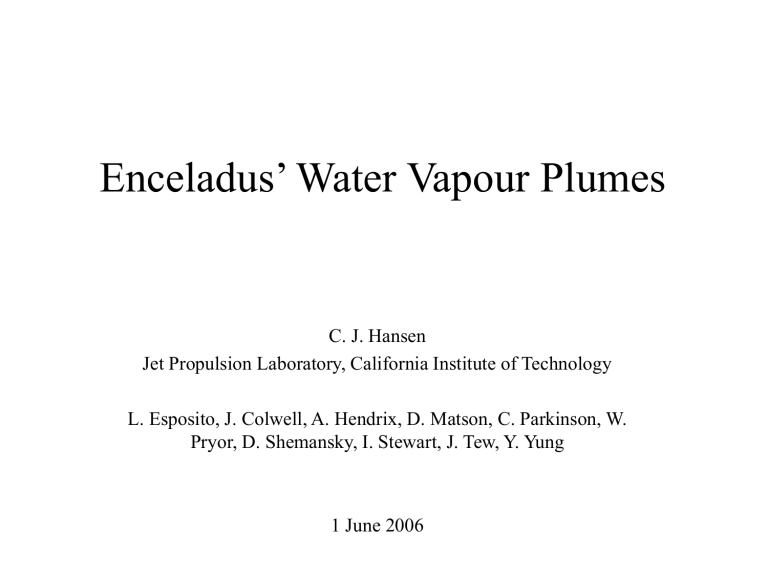
Enceladus’ Water Vapour Plumes
C. J. Hansen
Jet Propulsion Laboratory, California Institute of Technology
L. Esposito, J. Colwell, A. Hendrix, D. Matson, C. Parkinson, W.
Pryor, D. Shemansky, I. Stewart, J. Tew, Y. Yung
1 June 2006
Enceladus is now known to be a Geologically Active Body
Cassini flew by Enceladus three times in 2005, in
February, March and July
We made the remarkable discovery of plumes coming from the southern pole
All of Cassini’s instruments contributed to our understanding of this fascinating phenomena
Results were reported in a special issue of Science,
10 March 2006
This image was acquired in November 2005, and shows
Enceladus’ backlit plume extending 435 km above the surface
CASSINI - HUYGENS
Microwave Remote Sensing
RADAR: Cassini Radar
RSS: Radio Science Subsystem
Magnetosphere and Plasma Science
CAPS: Cassini Plasma Spectrometer
CDA: Cosmic Dust Analyzer
INMS: Ion and Neutral Mass Spectrometer
MAG: Dual Technique Magnetometer
MIMI: Magnetospheric Imaging Instrument
RPWS: Radio and Plasma Wave Science
Optical Remote Sensing (ORS)
CIRS: Composite Infrared Spectrometer
ISS: Imaging Science Subsystem
UVIS: Ultraviolet Imaging Spectrograph
VIMS: Visible and Infrared Mapping Spectrometer
Cassini Tour Overview
Cassini’s prime mission is 4 years
In that time the spacecraft
• orbits Saturn 78 times
• flies by Titan 45 times
• has 8 close flybys of
Saturn’s icy moons, including 4 of Enceladus
QuickTime™ and a
Animation decompressor are needed to see this picture.
Pre-Cassini View of Enceladus
• The best Voyager images of
Enceladus showed a geologically young surface
• Enceladus’ orbit co-incides with the peak E ring density
Hypothesis: Eruptive activity on
Enceladus is the source of the E ring
-> Enceladus was a major target for the Cassini mission
Four close flybys were planned into Cassini’s tour of the Saturnian system (3 in
2005, 1 in 2008)
Enceladus Flybys in 2005
Orbit 3
Range = 1259 km
Subs/c lat = 20 0
Subs/c lon= 308 0
Orbit 4
Range = 497 km
Subs/c lat = -17 0
Subs/c lon = 254 0
Orbit 11
Range = 168 km
Subs/c lat = -51 0
Subs/c lon = 218 0
Atmosphere on Enceladus?
• Draped field lines observed by the Magnetometer in February were the first evidence for some sort of an atmosphere
• Enhanced ion cyclotron wave activity observed at water group ion gyrofrequency
Enceladus lambda Scorpii Occultation
Enceladus’ youthful geology motivated UVIS observations of stellar occultations, to search for tenuous atmosphere and/or eruptive plumes but no signature of an atmosphere was observed by UVIS in
February
February Lambda Scorpii
Occultation
Ingress
Egress
March 2005 Flyby - More Youthful Geology
July 2005
The July flyby flew more directly over the south pole of
Enceladus
Results from many
Cassini instruments suddenly made sense when we realized we were seeing evidence for eruptions at the south pole
Bluish fissures crossing the south pole were dubbed “tiger stripes”
ISS Color Mosaic
Rev 11
Enceladus Stellar Occultation Geometries
February Lambda Scorpii
Occultation
July Gamma Orionis
Occultation
Egress Ingress
Detection of Plume: High Speed Photometer
(HSP) vs. Time
• Clear indication of attenuation of signal during occultation ingress; egress is signature of HSP warmup
• Start to sense atmosphere ~24 sec prior to hard limb occultation, maybe as much as 30 sec (FUV)
• Ray height at –24 sec is ~ 155 km
Localization of Enceladus’ Plume
(Not a global atmosphere)
•
Ray intercepts were at latitude / west longitude:
15 / 300
-31 / 141
-76 / 86
-0.2 / 28
Lambda Sco ingress (non-detection)
Lambda Sco egress (non-detection)
Gamma Ori ingress
Gamma Ori egress (non-detection)
Consistent with localized plume or jet:
– Enceladus’ gravity insufficient to hold gravitationally bound sputtered atmosphere
– Also, the combination of other
Cassini data sets are consistent with a plume of water vapor coming from Enceladus’ “Tiger
Stripes” driven by the hot spot at the south pole detected by CIRS
FUV Data: Comparison of Occulted to
Unocculted Spectra
FUV configuration:
• spectral channels binned by 2
(512 spectral channels from
113.5 nm to 191 nm)
• low resolution slit width
• 5 sec integration time
• full spatial resolution
Time record 33, the last full
5 sec integration prior to ingress, shows the deepest absorption. The ray altitude above Enceladus’ surface corresponding to time record 33 ranged from
30 to 7 km.
Clear signature of an atmosphere is present – both relatively narrow and broad absorption features
Composition of Plume is Water Vapour
I=I
0 exp (-n*
)
I
0 computed from
25 unocculted samples n = column density
= absorption cross-section, function of wavelength
The absorption spectrum of water (pink line) is shown compared to Enceladus’ plume spectrum (I/I
0
) for a column density of n = 1.5 x 10 16 cm -2
The increase in water abundance is best fit by an exponential curve – a comet-like evaporating atmosphere (1/R 2 ) does not fit the data well, nor do global hydrostatic cases
The best fit scale length is 80 km
Structure of the Plume
Cassini clipped edge of plume:
INMS, CDA in situ Results
• ~1 minute before closest approach the
Cosmic Dust Analyzer detected a peak in the number of small particles (blue diamonds), 460 km altitude
• 35 seconds before closest approach the Ion
Neutral Mass
Spectrometer measured a large peak in water vapor (yellow diamonds), 270 km altitude
• Gas and dust plumes are decoupled at these altitudes
CDA Peak INMS Peak
INMS Plume Composition
Cassini’s Ion Neutral Mass Spectrometer detected mass spectra consistent with a plume composition of:
91 %
3.2 %
4 %
1.6 %
+/- 3%
+/- 0.6%
+/- 1%
+/- 0.4 %
H
2
O
CO
2
CO or N
2
(28 amu)
CH
4
Trace quantities, <0.5 - 1 %, of
Propane
Acetylene
HCN
CO Limit
•
The Ion Neutral Mass Spectrometer (INMS) detected a species with mass = 28 amu, consistent with either N
2 or CO
• UVIS should have detected CO:
– Used absorption cross-sections from Eidelsberg, 1992
– “Require” 10% dip in signal for positive detection
I/I
0
= 0.9 = exp (-nα) for α = 820 x 10 -18 at 1477.6 Å
-> n = 1.3 x 10 14 cm -2 upper limit, ~1%
• VIMS also places an upper limit of ~ 10 14 cm -2
•
Implies an INMS detection of N
2 since UVIS should have seen 3% CO
Models for Enceladus’ Plumes
These preliminary models illustrate possible mechanisms for powering
Enceladus’ plume
New determination of Enceladus’ density
(1.608 gm/cm 3 ) have increased the estimate for potential radiogenic heating in the interior
No NH
3 detection is problematic
Biggest issue is how to condense grains from gas or entrain particles from the surrounding ice matrix
Current leading candidate model is a chamber of liquid water under pressure, with a vent to the surface
Cloud of gas and ice is produced if liquid is carried along with vapor and freezes as it expands out of the vent, easily reaching escape velocity
Liquid chamber could be as close as 7m to the surface
Cold Geyser Model
Neutral Species in Saturn’s System
• The Saturnian system is filled with the products of water molecules:
– H detected by Voyager in 1980, 1981
– OH detected by Hubble Space Telescope in 1992
– Atomic Oxygen imaged by UVIS in 2004
“Search for the Missing Water Source”
1
Neutral Species
• Water and its products are lost from the system by collisions, photoand electron- dissociation and ionization
• Estimates of required re-supply rates, water molecules/sec:
• 2.8 x 10 27
• 3.75 x 10 27
• 10 28
• 2 x 10 28
1993
2002
2005
2005
Shemansky, et al.
1 Jurac, et al.
Jurac and Richardson
Shemansky, et al.
E Ring
• Saturn’s E ring, composed primarily of 1 micron particles, is also subject to erosion and loss due to sputtering of water from the surface of the E ring’s dust particles and collisions of particles with Saturn’s moons
• Estimate of required re-supply rate:
• 1 kg / sec
2002 Juhasz and Horanyi
Estimation of Water Flux from Enceladus
•
S = flux
= N * h 2 * v
= n/h * h 2 * v
= n * h * v
Where
N = number density / cm 3 h 2 = area v = velocity n = column density measured by UVIS
The biggest uncertainty is what to use for h
Estimate h from plume dimension, = 80 (from scale length) or 175 km (from horizontal distance traversed)
Estimate v from thermal velocity of water molecules in vapor pressure equilibrium with warm ice (41,200 at 145 K or 46,000 cm/sec at
180 K – note that escape velocity = 23,000 cm/sec) v h
S = 1.5 x 10 16 * (80 or 175) x 10 5 * (41 or 46) x 10 3 = 0.5 to 1.2 x 10 28 H
2
O molecules / sec
= 150 to 360 kg / sec
• A new model has been developed for Enceladus’ plumes by Tian, Toon,
Larsen, Stewart and
Esposito, paper submitted to Icarus
• Monte Carlo simulation of test particles given vertical + thermal velocity, particle trajectories tracked under influence of gravity and collisions
• Assumes source of one plume is 2 x 2 km 2 , then multiple plumes added together along a tiger stripe, separated 20 km
New Plume Model
UVIS ray path across tiger stripes
Monte Carlo model results - Predicted Plume Shape
Monte Carlo Model - Fit to Data
Best fit to UVIS column density as a function of altitude requires a vertical velocity of
300 to 500 m/sec
New calculation of water flux is 4 - 6 x 10 27 molecules/sec, consistent with lower rate from previous estimate, = 120 - 180 kg/sec
Dust in the Plume - Is Enceladus the source of
Saturn’s E Ring?
Enceladus as source of E Ring was first proposed in 1981 by Terrile and
Cook, based on coincidence of peak density of E ring with Enceladus’ orbit
Lifetime of 1 micron grains is short (<50 years)
E ring re-supply required is 1 kg/sec
• Comet analogy, using UVIS water vapor mass
• If dust-to-gas ratio is comet-like then ratio ranges from 0.1 to 2
• 0.1 x 150 kg/sec > 1 kg/sec required
• ISS results on dust densities suggest that the ratio is much lower - just
0.04 kg/sec of 1 micron particles
• From the rate of impacts on the CDA High Rate detector the particle escape rate is inferred to be 5 x 10 12 particles/sec or 0.2 kg/sec assuming all grains have a radius of 2 microns
Enceladus is spewing water into the Saturnian system
VIMS data appear to confirm that
Enceladus is the source of the E ring:
Spectrum of the plume is a match to the E ring however… the mass budget from
ISS and CDA results seems insufficient
Implies temporal variability in the intensity of
Enceladus’ eruptions
Detecting Temporal Variability
The water budget derived from the water vapor abundance shows Enceladus supplies most if not all of the OH detected by HST, atomic oxygen in the Saturn system detected by UVIS
Implies activity for > 15 years
Since the oxygen in the system comes from Enceladus UVIS may be able to remotely monitor Enceladus’ activity levels by monitoring the system oxygen level
Changes in System Oxygen Content
0.8
0.7
0.6
0.5
3.0
2.8
2.6
2.4
2.2
1.2
1.0
0.8
1.1
2.0
1.8
1.6
1.4
1.0
0.9
0.4
0.3
0.2
0.1
0.0
0
(a)
(b)
100
Weekly O1304 Trend
200
Z: +5/-5 R s
, X: -6/-10 R
Z: +5/-5 R s
, X: 0/+6 R s
Z: +5/-5 R s
Z: +5/-5 R s s
, X: +6/+10 R
, X: 0/-6 R s s
500 300 400
Elapsed Time (days)
600 700
Detectable Effects on Magnetosphere
At Enceladus
• Some of the neutrals in the plume are ionized by charge exchange
• Fast-moving co-rotating plasma overtakes Enceladus, gets slowed down by mass-loading of slow-moving Enceladus plasma
•
Plasma flow (sensed by CAPS) is slowed and diverted at a distance of 27 R
E
In Saturn’s magnetosphere, away from Enceladus’ immediate vicinity,
•
The neutral density dominates the plasma density
– Large tori of H, OH, O
• Charge exchange is the primary ionization process and proceeds slowly, resulting in relatively long average neutral lifetimes (~70 days)
•
Heavy ions supplied to inner magnetosphere are gradually accelerated to corotation velocity, transported outward
Enceladus L shell crossings show
• Changes in absorption signatures of energetic electrons suggest plume variability on time scales of days to weeks
2008 Enceladus Flyby
Cassini will fly by Enceladus again on March
12, 2008
This is a polar pass, with the closest approach near the equator
We approach from the unilluminated side
Just minutes after Cassini passes to the illuminated side Enceladus goes into eclipse
The closest approach distance has not yet been finalized but will be < 100 km
We expect to clip the plume again on the southbound asymptote
Intrigued by Enceladus
Enceladus will be an important target for more flybys in Cassini’s extended mission
Enceladus should be the destination for a future mission!
